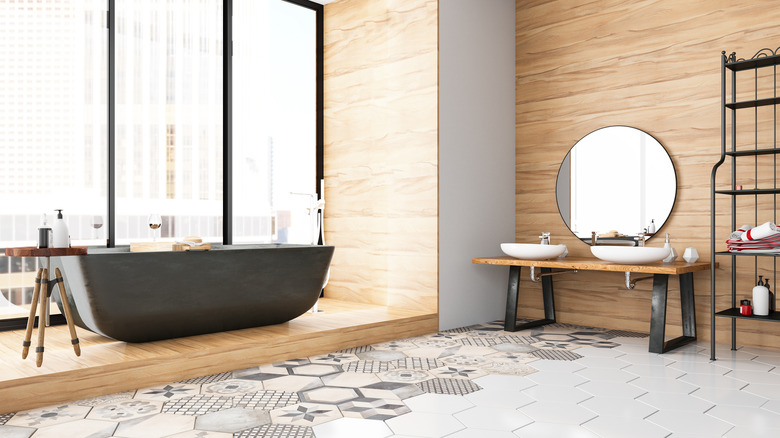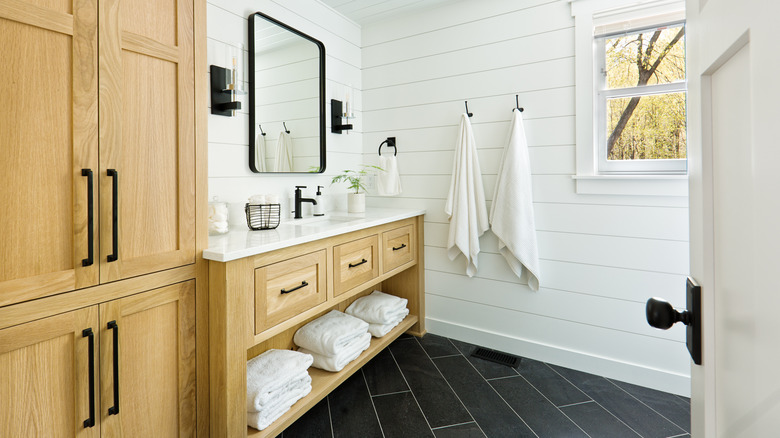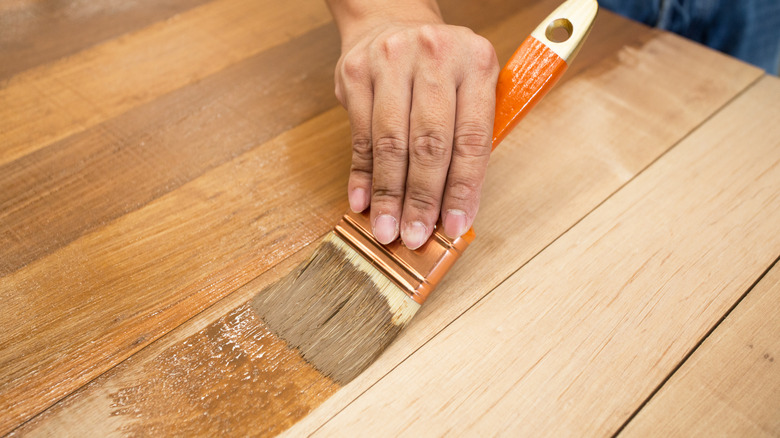The Types Of Wood That Will Hold Up To The Humidity In Your Bathroom
Wood surfaces on your floors, walls, vanities, or cabinets can give your home a cozy, rustic appearance. When it comes to the bathroom, though, you can't just choose whichever style you think looks the best. You have to consider wood's higher susceptibility to mold and mildew growth, compared to other surfaces. This is due to wood's porous nature, so many people use plywood in their bathrooms. While the easiest way to deal with mildew is to never let it build up in the first place, some woods can stand up to the bathroom humidity test.
Baltic birch plywood is a great and popular option that can hold up well to bathroom humidity (via Intrism). Certain types of hardwood, like solid teakwood and cedar wood, can also do well in a high-moisture area, as Modern Timber Craft explains.
In some residential bathrooms, the only place you'll find wood is in the cabinets or vanities, but that doesn't mean your bathroom has to have that limitation. Perhaps you have your heart set on having wood flooring or wall paneling, or a wooden shower seat. Well, you can! If you select the right type of wood and ensure that it's treated (if needed), you can have wood in multiple areas in your bathroom.
Why plywood and certain hard woods hold up well in a bathroom
Identifying mold and getting rid of it can be quite a pain for homeowners. For that reason, many bathroom cabinets and vanities are made from exterior-grade plywood, a type of engineered material that includes multiple glued layers of real wood veneer. The glue in exterior-grade plywood causes it to be resistant to moisture (via FA Mitchell & Co Pty Ltd.). Baltic birch plywood is even more resistant, due to the natural oils found in the birchwood. This makes it an ideal selection for your vanity, cabinets, or wall paneling.
Solid teakwood is a type of honey-colored, dense hardwood that naturally bears moisture-resistant, rot-resistant, and mold-resistant qualities. It's also one of the strongest types of wood, making it a perfect choice for a frequently humid room, like a bathroom. Teakwood can be used for your bathroom floor, shower seat, or cabinets. Another added perk to this type of wood is that it emits a woodsy fragrance, which is why it's used in candles, body washes, and other scented products. Hello, Bath and Body Works.
Cedar wood shares several of the same characteristics as teakwood, including its durability and resistance to mildew and decay. However, it's not quite as sturdy or hard as teakwood, but on the plus side, this typically means that cedar wood will cost less. In a bathroom, this warm-hued wood with its balsamic, earthy scent is a popular choice for wall paneling and even ceilings.
The importance of treating wood in high-moisture areas
Treating wood means applying a mixture of preservative chemicals to protect it against fungi, like mold, to ultimately prolong its life. Treated wood is also known as "finished" wood. Oils, varnishes, and paints are among the chemicals used in wood treatments. Many wooden bathroom furniture pieces sold in stores come pre-treated, but you may be interested in purchasing unfinished pieces to save money. Or, perhaps you want to take the DIY route or know someone who can make your red cedar cabinets for you. If this is the case, make sure to coat it with the necessary protectants before it's installed in your bathroom.
Although cedar is naturally resistant to decay, it should be treated if it's installed in a high-moisture area, like your bathroom. Among the things to know about water-proofing wood is that teakwood produces its own oils naturally to give it water-resistant qualities, which means it doesn't require any treatment. Baltic birchwood plywood is usually already treated before it makes it to store shelves.
So long as you select a type that's been pre-treated/finished or that produces its own moisture-resistant oils naturally, wood can be used in various areas of your bathroom.


